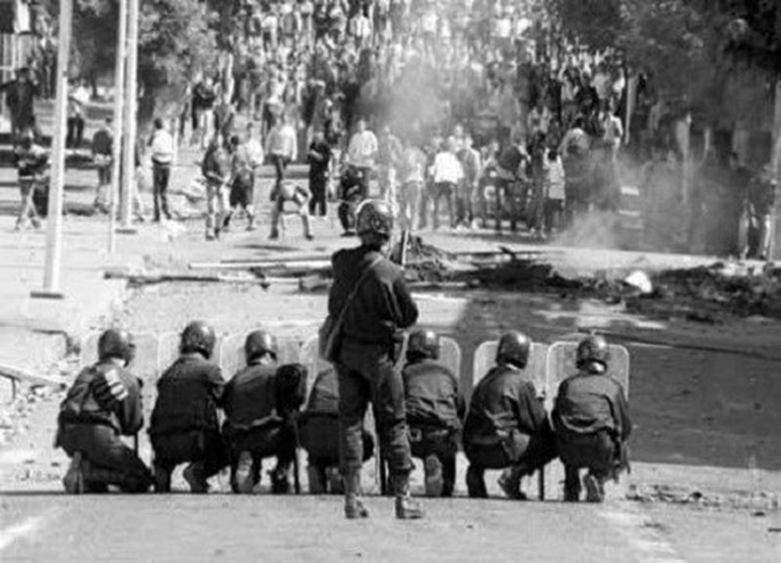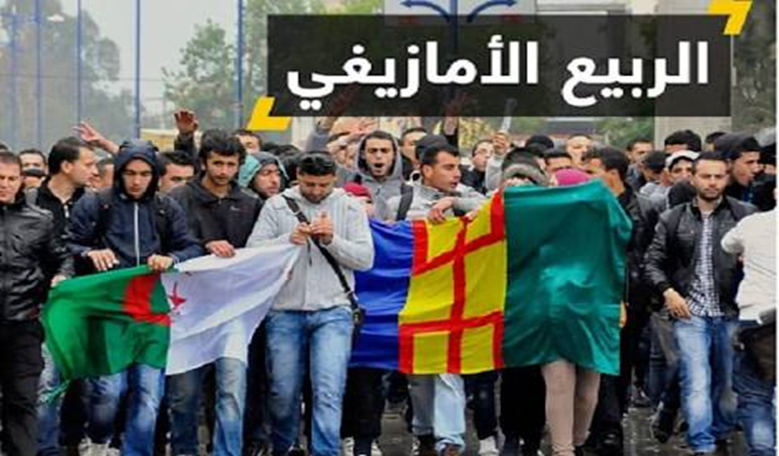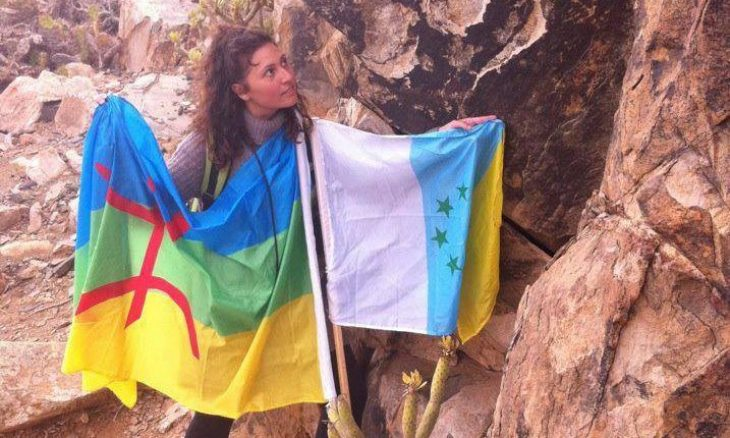Rachid Raha, president of the AMA: "In 43 years of struggle, Amazighity has made many achievements but it remains insufficient"

Rachid Raha, President of the Amazigh World Assembly
43 years have passed on this Berber revolt born in the university of Tizi-Ouzou, capital of Kabylie, following the ban on the holding of a conference that Mouloud Mammeri, Algerian writer was to animate
For several days all the towns and villages of Kabylie were in turmoil. The Berber volcano pours its lava as far as Algiers, revealing to the world a cause, hitherto taboo, which has the name “Tamazight” or “Amazighity” better known under the French name “Berber”. Neither the arrests of dozens of demonstrators nor the repression that fell on the entire Kabyle population got the better of the fierce will of young activists eager to reconnect with their history as free men hidden by the intrusion of a pan-Arabism totally foreign to Algeria and all of North Africa.

Since April 20, 1980, the Amazigh cause has been taken head on by the peoples of this space which extends from the oasis of Siwa in Egypt to the Canary Islands in Spain. This space was called Tamazgha. The country of the Free Men which is the exact translation of "Amazigh".
To tell us about the achievements of this struggle and its prospects, we cannot find better than Rachid Raha, the president of the Amazigh World Assembly. This tireless militant, 59 years old, born in Nador in the Moroccan rif considered one of the strongholds of the Amazigh struggle, devotes all his life and all his energy to this cause in which he deeply believes. Journalist, anthropologist and political activist, he is the author of several books and publications in French, Spanish and Amazigh in which he presents the results of his research and expresses his thoughts.

And since there is a woman behind every great man, Rachid Raha relies on Amina Ibnou Cheikh, his wife and mother of his only son, to provide him with advice and support and to brilliantly direct the fundamental tool of his fight, the monthly “Le Monde Amazighe” published in three languages, Amazigh, Arabic and French.
Through this interview that he was kind enough to grant us, Rachid Raha gives us an update on the achievements of 43 years of struggle to restore Tamazight to its rightful place on its own land.
In celebrating the 43rd anniversary of the Berber Spring, in your capacity as President of the World Amazigh Association, would you mind giving us a brief account of nearly half a century of struggle for the rehabilitation of and the promotion of Amazigh culture?

Indeed, since the "Berber spring", - which took place on April 20, 1980 at the University of Tizi-Ouzou following the banning of the late Mouloud Mammeri's conference on Kabyle poetry -, until today many things have happened, many events have taken place and great changes have taken place. Identity, political or cultural awareness of the "Amazigh fact" has spread from Kabylia to other Algerian regions, has crossed the sea to the Amazigh diaspora in France, and then to Europe, and has surpassed the artificial borders of North African countries. With the fall of the Berlin Wall in 1989, people woke up and freed themselves from authoritarianism. The Amazighs did not stay away.
Major events have since taken place, such as the satchel strike in Kabylie in 1994 and 1995, consisting in boycotting schools until the authorities introduce the teaching of the Amazigh language in public schools. On May 1, 1994, Moroccan activists were detained and imprisoned for daring to hold up a banner written in Tifinagh. Then there was the unfortunate “black spring” of 2001 when the Algerian gendarmerie murdered 126 young people with impunity without anyone being brought to justice! … But one of the most significant events of Amazigh dynamism is the fact of wresting recognition of the official status of the indigenous Amazigh language in 2011 in Morocco and in 2016 in Algeria!

While the Algerian Amazigh community is the trigger for the Amazigh awakening and was at the forefront of cultural demands, we see today that in Morocco there are significant achievements, the most recent of which is the establishment in parliament Moroccan simultaneous translation from and into the Amazigh language in plenary sessions. Do you believe that in Algeria there is a slowdown in the struggle?
In Morocco, where any political formation based on Amazighity has been banned (the case of the PDAM created by the late master and friend Ahmed Adghirni), the Amazigh cause has received great attention from the authorities, even if the conservative governments of the PI and the Islamist PJD have tried to put a spoke in the wheel to block its promotion, because of their retrograde Arab-Islamist ideology, and despite its recognition by the Head of State, the King Mohamed VI, in his famous speech in Ajdir on October 17, 2001.

Today, with the new government of Aziz Akhennouch, who had assumed in the electoral campaign of the elections of September 8, 2021 of his party the RNI, the demands of the Amazigh movement, the Amazigh cause has become a state affair. His government has the merit, for the first time in the political history of independent Morocco, of dedicating a budget for the implementation of the official character of the Amazigh language within the administration.
Thus, in the courts and in the chambers of parliament, there are now native language translators. On the other hand, the weak point of this new liberal government is the underestimation of the importance and the urgency of the generalization of the Amazigh language in preschool and in the primary cycle, on the part of the current Minister of National Education! Something that we have just denounced recently to the World Bank.

If, today, in Morocco, the Amazigh question is no longer a taboo, as it was during the 1970s and 1980s (when the linguist Boujemaâ El Habbaz was assassinated for the simple reason of a thesis on his mother tongue, where the historian Ali Asadqi Azayku was imprisoned in 1981 for having dared to ask to review the official history!), in Algeria, unfortunately, the situation has deteriorated a lot. And this unfortunate demotion has become more and more aggressive since the appearance of the “Aarouchs” movement in 2001 and the “Algerian Hirak” of February 2019 when the authorities began to ban Amazigh flags. With the illegitimate and anti-democratic government of Abdelmajid Tebbounne and General Said Chengriha, the repression took on unprecedented, incomprehensible proportions. The police and judges in the pay of the military junta continue to imprison hundreds of Amazigh activists, human rights defenders and journalists. Add to this the persecution and unfounded accusations of pacifist movements classified as terrorist, as is the case of the Movement for the Self-determination of Kabylie (MAK)!
You made visits to Libya and Tunisia where Amazighity was in a state of neglect. What progress has been made in these two countries?

Last year, indeed, I had the opportunity to visit Tunisia and Libya. In these two countries, the Amazigh question is evolving positively and very differently. If in Tunisia, the claim is assumed more and more by Arabic-speaking and Arabized Tunisians, it remains of cultural essence. However in Libya, the Amazigh question has become crucial for the future of this country, and more particularly, for the Amazigh populations of the coastal region of the Zouaras and the tribes of Jebel Nefoussa, and the Tuareg communities in the southwest. What I admire about the Libyan Amazighs, unlike the Tuareg revolutionaries of Azawad (in the north of Mali), is that at the same time that they were engaging in the revolution against the dictator Muammar Gaddafi, they embarked on a cultural revolution, fundamentally based on the teaching of the Amazigh language and its Tifinagh spelling to the students of their popular schools. It is truly an extraordinary experience. They did not wait for its recognition in the Constitution or the decisions of the central authorities, in this case the Ministry of National Education!
What about Amazigh in the Canary Islands, where the city of Tafira hosted the first Amazigh gathering in 1997?
In the Canary Islands, which I just visited in February, unfortunately the regional government and local authorities do little to promote Amazigh culture. The Canarian Amazigh activists even confessed to me that the holding of the First Congress of the Amazighs of the World that we had organized in Tafira in August 1997 brought them more harm than encouragement! Generally, those who defend the Amazighity and Africanity of the Islands the most are the independence activists, sympathizers of the late Master Antonio Cubillo (companion of the late Mouloud Mammeri whom I met in Tizi Ouzou during the "Berber spring" of 20 April 2000) and movements resulting from the successive divisions of its anti-colonial movement,

The great paradox of the Canary Islands is that enormous importance is given to archeology and all the islands have 150,655 superb and rich ethnographic museums. But unfortunately, some Canarian intellectuals, journalists and archaeologists try at all costs to dissociate them from the Amazighs. As Chona Del Toro, the president of the Azar association told me, they want us to believe that the ancestors of the Guanches had wings and came down from the sky!!!
However, what caught my attention more is that the "Spanish" educational authorities convey the false idea that Canarians learn their own language, a rather special language, in that it differs just a little from the Castellane language. phonetically, and which it considers to be an authentic language of the regional autonomy of the Canary Islands, following the example of Catalan in Catalonia or Euskera in the Basque Country, whereas the true language of the Canarians is a variant of the Amazigh language, very close to tachelhit, which they lost just around the 18th century!
Precisely, about the language, the detractors of Amazigh reproach it for the absence of a single language which constitutes the unifying cement of the Imazighen. What do you intend to do to carry out this project of unification of the Amazigh language?
Normally, as I had already written in the Moroccan magazine Tifinagh n°7 of September 1995, the common Amazigh language already exists, and quite simply, it is the speaking of the Middle Atlas! This is normal, because this mountainous region of central Morocco is quite a distance from the coast. This is what safeguarded it from Punic, Roman, Turkish, Arab and European settler linguistic-cultural influences. A language that retains all its authenticity. And my personal thesis, without being a linguist, was validated when Miloud Taifi of the University of Fez compared texts from different Amazighophone regions of Morocco and Algeria (the Kabyle) he found that the most shared lexicon is that of the speakers of the Middle Atlas. Something that the Riffian linguist Mohamed Seroual of the University of Tetuan confessed to me when he was preparing his doctoral thesis on the Riffian dictionary. Syntactically, likewise, the linguist from the University of Toulouse Michel Quitout, comparing the grammar of several dialects, came to almost the same conclusion, it is the dialect of the Zayan tribes that has the most linguistic kinship with other Moroccan and Algerian dialects. Even Michael Peyron, one of the greatest connoisseurs of Amazigh literature, supports my idea. In addition, about neology, the late Mouloud Mammeri was one of the pioneers to formulate a standard dictionary, drawn from Tuareg sources, still within the most isolated desert regions of the world! In the monthly publication,
Moreover, in our ambitious political project of "Manifesto of Tamazgha", the objective of which is the construction, in the future, of a true Union of the States of North Africa, taking inspiration from the example of the European Union, we recommend that the Amazighs should assume bilingualism, that they keep their regional languages within the political autonomy of their indigenous region and learn, alongside, the standardized standard Amazigh language, in order to set it up to be the communication medium for all North Africans, and all Amazighs, instead of doing it in Arabic or French!
The teaching of Tamazight in the two flagship countries of Algeria and Morocco is far from meeting the expectations of the populations since Tamazight is only taught in a few schools and in only a few regions. What do you plan to do for the generalization of the teaching of Tamazight at least in these two countries?

Indeed, despite the fact that the Amazigh language is recognized as an official language, alongside the Arabic language, in Morocco and Algeria - a dream come true for the pioneers and all Amazigh activists - the Amazigh language, unfortunately, is losing ground. It is in danger of disappearing in certain areas, such as Ghomara and Senhadja Srair in the Rif or Figuig! Amazighophone parents in some urban centers prefer to speak to their children in "Darija", the dialectal Arabic, believing that they facilitate the integration of their children into school. They are totally mistaken and this is what I have just pointed out in my recent correspondence to the officials of the World Bank, deposited at its headquarters in Rabat, on April 10, where I warned them of the urgent generalization of the teaching of the Amazigh language in preschool and primary school, while waiting to extend it to the secondary cycle. This is the most effective and appropriate way to save schools and children in our North African countries. This would undoubtedly contribute to the success of the International Decade of Indigenous Languages 2022-2032 and to ensure the survival of the millennial indigenous Amazigh language*

(*)http://amamazigh.org/2018/10/manifeste-de-tamazgha-pour-une-confederation-democratique-sociale-et-transfrontaliere-basee-sur-le-droit-a-lautonomie-des-regions-2/
(**) http://amamazigh.org/2023/04/lassemblee-mondiale-amazighe-interpelle-la-banque-mondiale-sur-le-sujet-de-la-sauvegarde-de-lecole-marocaine/
Source : websites

